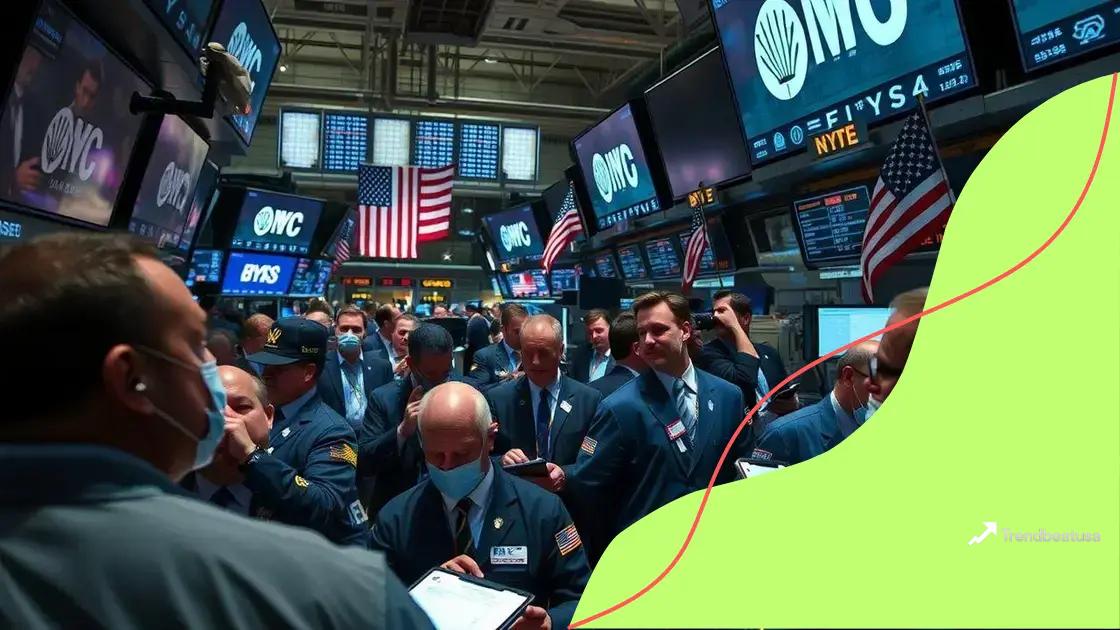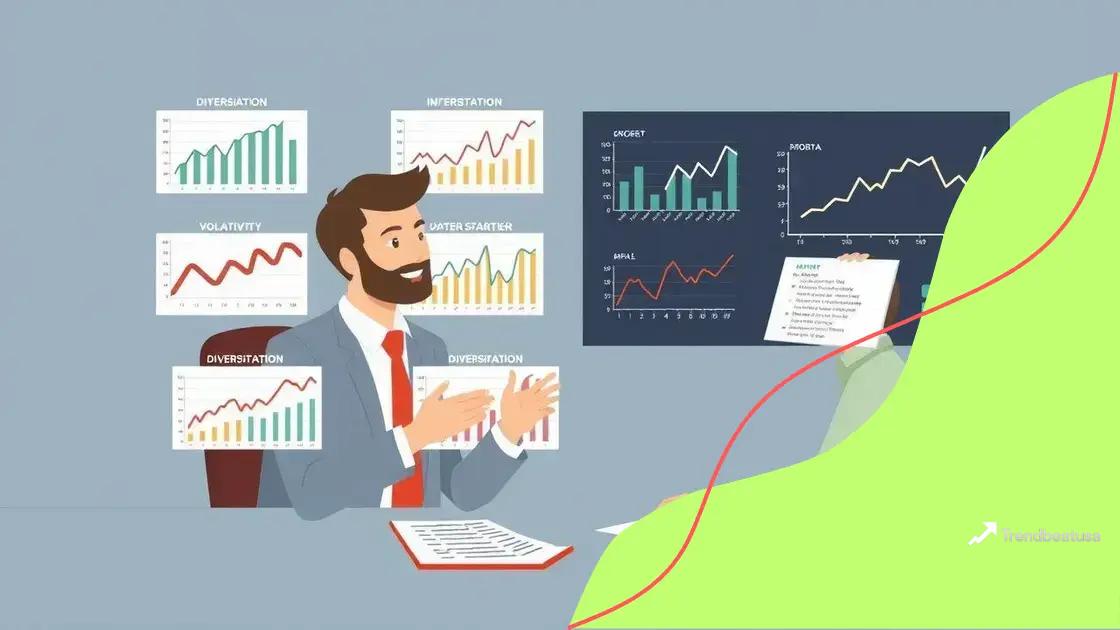Trade tensions drive market swings and how to navigate them

Trade tensions drive market swings by creating uncertainty that impacts global economies, affecting consumer prices, investment strategies, and international relationships.
Trade tensions drive market swings, affecting economies worldwide. Have you noticed the fluctuations in stocks or currencies? Understanding these dynamics is crucial for investors looking to navigate this turbulent landscape.
Understanding trade tensions and their causes
Understanding trade tensions is essential in grasping the current economic landscape. These tensions can arise from various factors and can significantly impact global markets.
Trade tensions often stem from disagreements between countries over trade policies, tariffs, and regulations. Let’s explore the main causes that lead to these situations.
Common Causes of Trade Tensions
Several factors can trigger trade tensions:
- Tariffs: Imposing taxes on imports can lead to retaliatory measures.
- Trade deficits: Persistent imbalances can cause disputes between nations.
- National security: Countries might restrict trade based on security concerns.
- Economic policies: Subsidies and regulations may also create friction.
Furthermore, rising economic nationalism in some countries is contributing to these tensions. Leaders are increasingly focusing on domestic interests, leading to stricter trade measures.
Impact on Global Markets
The effects of trade tensions ripple through economies, affecting everything from prices to employment. As tariffs increase, the cost of goods rises, influencing consumer behavior. This can lead to reduced spending and a slowdown in economic growth.
Moreover, uncertainty regarding trade agreements can create a volatile environment for investors. When markets perceive risk, they often react with swings in stock prices. Understanding these dynamics is key for managing investment strategies effectively.
How market swings affect investments
Market swings have a major impact on investments. Understanding how these fluctuations occur is crucial for making informed decisions. A sudden drop or rise in the market can change the landscape for investors.
Effects on Investment Strategies
When market swings happen, it can lead investors to adjust their strategies. Some common reactions include:
- Reallocating assets: Shifting investments to less volatile areas can stabilize a portfolio.
- Emotional responses: Fear or excitement might drive impulsive decisions, which could be detrimental.
- Long-term planning: Market fluctuations can encourage investors to focus on long-term goals instead of short-term gains.
Investors often feel anxious during periods of significant volatility. It’s important to stay calm and evaluate the situation logically. For instance, if a stock drops due to a general market dip rather than a specific issue with the company, it may present a buying opportunity.
Impact on Different Types of Investments
Different asset classes react uniquely to market swings. Stocks may see sharp movements, while bonds often remain more stable. Understanding these differences is key for diversification:
- Stocks: High volatility means potential for large gains or losses.
- Bonds: Typically, they provide steadiness in uncertain times.
- Real estate: Tends to be less affected by daily market fluctuations but can still feel the impact.
As we navigate these fluctuations, recognizing how market swings can affect investments empowers individuals to make thoughtful choices. Educational resources and professional advice can also enhance an investor’s ability to adapt.
Strategies to mitigate risk during volatility

In times of market volatility, having strategies to mitigate risk is essential for investors. These strategies help protect investments and ensure stability, even when markets are fluctuating.
Diversification
One key strategy is diversification. By spreading investments across various asset classes, such as stocks, bonds, and real estate, you can reduce exposure to any single market downturn. This approach helps to balance risk and reward.
- Include different sectors: Investing in various industries can shield you from sector-specific downturns.
- Geographic diversity: Consider assets in different countries to minimize local economic impacts.
- Mixing asset types: Combining stocks with safer investments like bonds can provide overall stability.
Another effective method is setting stop-loss orders. These orders automatically sell an asset once it hits a certain price. This strategy prevents larger losses during sharp declines and is especially useful in volatile markets.
Maintaining a Long-Term Perspective
Staying focused on long-term goals is also crucial. During periods of volatility, it can be tempting to react emotionally. However, maintaining a long-term outlook allows you to ride out fluctuations and avoid panic selling.
Additionally, cash reserves can provide a buffer against volatility. Keeping cash on hand allows investors to take advantage of market dips by buying quality assets at lower prices.
Regularly reviewing your investment portfolio is crucial. Adjustments may be needed based on changing market conditions or personal financial situations. Continuous education about market trends also plays a vital role in staying informed and making strategic decisions.
Historical examples of trade tensions impact
Understanding historical examples of trade tensions helps us learn from past experiences and predict future impacts. Various notable instances illustrate how trade disputes can disrupt economies and markets.
U.S.-China Trade War
The trade war between the United States and China is a prime example. In 2018, the U.S. imposed tariffs on numerous Chinese goods, leading to retaliatory tariffs from China. This conflict caused significant shifts in global markets, affecting prices and availability of products.
- Rising Costs: Tariffs led to increased costs for consumers and businesses.
- Market Volatility: Uncertainty regarding trade agreements caused stock market fluctuations.
- Shifts in Supply Chains: Companies began relocating production to avoid tariffs.
This situation demonstrates how trade tensions can lead to widespread economic changes.
Smoot-Hawley Tariff of 1930
Another significant example is the Smoot-Hawley Tariff Act. During the Great Depression, the U.S. raised tariffs on over 20,000 imported goods. This move aimed to protect American businesses but had dire consequences.
Many countries retaliated with their own tariffs, resulting in a sharp decline in international trade. The negative effects prolonged economic hardship and deepened the global recession.
NAFTA and Trade Negotiations
Trade agreements like NAFTA (North American Free Trade Agreement) also highlight the effects of tensions. Although intended to reduce barriers, debates surrounding the agreement often sparked trade tensions among member countries.
The renegotiation of NAFTA into the USMCA (United States-Mexico-Canada Agreement) demonstrated how leaders address these tensions. The process included addressing concerns over labor, environmental standards, and economic fairness.
These historical instances show that trade tensions not only affect policies but also have long-lasting impacts on economies around the world.
The future outlook for global trade relationships
The future outlook for global trade relationships is constantly evolving. As countries rethink their trade policies, the impacts of trade tensions will shape how nations interact economically.
Emerging Trade Agreements
One key aspect of this outlook is the formation of new trade agreements. Countries are increasingly looking to create deals that address today’s challenges such as technology transfer, environmental policies, and labor rights.
- Regional pacts: Countries are forming regional agreements like the RCEP (Regional Comprehensive Economic Partnership) to strengthen ties.
- Digital trade: With e-commerce on the rise, new rules governing digital trade are becoming essential.
- Sustainability focus: Future agreements might emphasize sustainable practices to protect the environment.
As these agreements develop, they can help reduce trade tensions by fostering cooperation and mutual benefits between nations.
Geopolitical Influences
The geopolitical landscape will also significantly impact global trade relationships. Rising powers and shifting alliances may lead to both challenges and opportunities. Understanding these dynamics is crucial for predicting how countries will engage in trade.
For instance, as countries like India and Brazil grow economically, their influence on global trade can reshape existing partnerships. This shift means that traditional trade powers like the U.S. and China may need to adapt or renegotiate their roles in the global market.
Technology and Innovation
Advancements in technology will also play a role in the future of trade. Automation, artificial intelligence, and blockchain technology are changing how goods are produced and exchanged. These innovations can streamline processes and increase transparency in trade, potentially reducing friction.
However, these changes could also lead to new trade tensions as countries grapple with the implications of such technologies on jobs and economies. It is vital for policymakers to proactively address these concerns to maintain stable trade relationships.
In conclusion, understanding the impact of trade tensions on global markets is essential for investors and policymakers alike. As we look to the future, new trade agreements, geopolitical shifts, and advancements in technology will shape how countries interact economically. By learning from historical examples and adapting strategies, nations can better prepare for the inevitable ups and downs of international trade relationships. Staying informed and flexible will help us navigate these challenges effectively.
FAQ – Frequently Asked Questions about Trade Tensions and Global Trade Relationships
What are trade tensions?
Trade tensions are disputes or conflicts between countries regarding trade policies, tariffs, or regulations that can affect global markets.
How do trade tensions impact consumers?
Trade tensions can lead to higher prices for goods due to tariffs, which directly affects consumers and their purchasing power.
Why is diversification important during trade tensions?
Diversification helps spread risk across different assets, reducing the negative impact on investments during times of market volatility.
What role does technology play in future trade relationships?
Technology advancements can streamline trade processes and create transparency, but they may also introduce new challenges regarding job displacement and competition.
